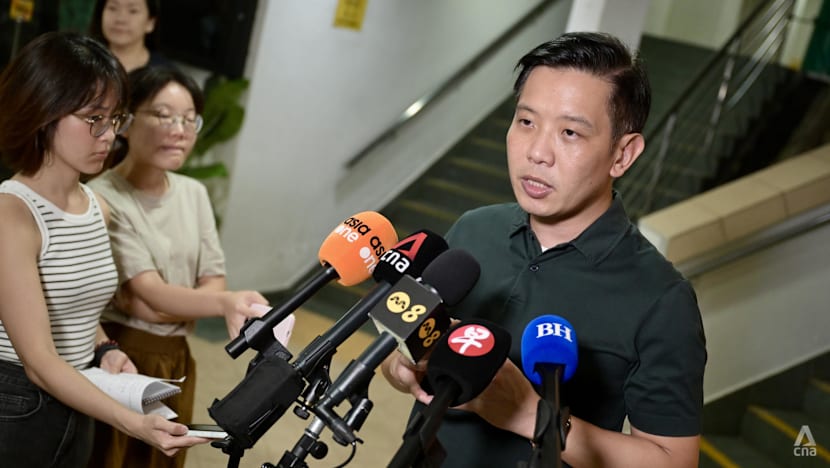Tailored programmes, infrastructure upgrades for concerned merchants in northern Singapore ahead of RTS Link
The Johor Bahru-Singapore RTS Link is expected to begin operations by the end of 2026.

Minister of State for National Development Alvin Tan speaking to the media at Marsiling Community Club on Oct 29, 2025. (Photo: CNA/Marcus Mark Ramos)

This audio is generated by an AI tool.
SINGAPORE: A government task force is studying targeted support and infrastructure upgrades to help merchants in northern Singapore brace for changes brought by the upcoming Johor Bahru–Singapore Rapid Transit System (RTS) Link.
Speaking to journalists after an engagement session with residents and merchants from Marsiling-Yew Tee Group Representation Constituency (GRC) on Wednesday (Oct 29), Minister of State for Trade and Industry Alvin Tan noted many such programmes are already ongoing nationwide.
“What might be fresh and what might be new is: how do we make these programmes even more tailored to the conditions in the north?” he added.
The RTS Link is expected to start operations by the end of 2026. In Singapore, it will connect directly to Woodlands North MRT station on the Thomson-East Coast Line.
Around the RTS Link station, new “flexible” industrial spaces will be developed for businesses seeking to tap into the Johor-Singapore Special Economic Zone, said Prime Minister Lawrence Wong in his National Day Rally speech in August.
New public housing is also planned, including 4,000 flats near Admiralty Park and additional homes along the Woodlands waterfront.
The prime minister said in August that the government plans to rejuvenate the northern region of Singapore with tens of thousands of new homes and improved transport links in Kranji and Sembawang.
When asked for specific examples of suggested improvements that can spur visitors to head to the region, Mr Tan, who is also Minister of State for National Development, said there were requests from merchants for more infrastructure, including canopies, covered linkways and playgrounds.
Residents and merchants also pointed to potential roads or carparks to improve accessibility or connectivity, he added.
“We are going into quite minute detail to find out what are the specific challenges and opportunities in the north, and then we can tailor these national programmes specifically to the north.”
These infrastructure improvements are “by no means trivial” and are “very important” because they help to drive traffic to businesses located in the north, said Mr Tan.
With the opening of the RTS Link and greater ease of crossing the Causeway using QR codes, shopkeepers in Woodlands and Marsiling fear that these developments will make Johor Bahru even more attractive to Singapore shoppers.
A task force to help Singaporeans and local businesses seize opportunities and reap the benefits from the upcoming RTS Link, chaired by Mr Tan, was announced in March.
In October, the task force held five engagements with a total of 160 people, including residents, merchants and trade associations, said Mr Tan on Wednesday.
The merchants are “understandably” concerned about whether the convenience afforded by the RTS Link will negatively impact their businesses, he added.
“I think that’s very understandable. Whether the people coming from Malaysia will spend at the shops, particularly in the northern area, and whether Singaporeans when they travel when it’s more convenient to go across to Johor, whether that will result in lower spending,” said Mr Tan.
These concerns were “anticipated”, he added. “But they are also excited about the ability to also go across and to have more people coming over to Singapore, particularly in the north.”
The task force will produce a report with its recommendations in the first half of 2026, said Mr Tan.
When borders were closed during the COVID-19 pandemic, merchants in the north saw a boost in traffic because residents could only patronise local shops, noted Mr Zaqy Mohamad, who is one of the People’s Action Party’s (PAP) representatives for Marsiling-Yew Tee GRC.
Businesses reported a 30 per cent to 40 per cent drop in revenue compared to the peak during the pandemic, he added, noting that people who live nearby now cross the border to “take advantage” of cheaper products and services.
One concern raised was how to bring traffic from Malaysia to these local businesses, driving it to the retail outlets and hawker centres in neighbourhood centres, said Mr Zaqy, who is also Senior Minister of State of Sustainability and the Environment.
While crossing the Causeway for shopping is attractive since items there “seem to be cheaper” because of Singapore’s currency, the neighbourhood centre “can never be replaced”, said fellow Member of Parliament representing Marsiling-Yew Tee GRC Hany Soh.
“The convenience there, the relationships that have been harnessed over the years between residents and merchants, going to the market knowing that you are here for a specific product on a weekly basis, these are things that are intangible relationships that will never be replaced,” she added.
Related:
Singapore and Malaysia inked an agreement to develop the Johor-Singapore Special Economic Zone, which aims to merge Singapore's R&D capabilities with Malaysia's industrial base and land resources.
The zone targets 50 cross-border projects and the creation of 20,000 skilled jobs over five years. To support it, Woodlands Checkpoint will be redeveloped in phases over the next 10 to 15 years, expanding to five times its current size.
The Johor-Singapore Special Economic Zone is part of a broader economic strategy that is meant to create an opportunity for businesses in both areas to compete as one unit, with a “strong value proposition”, he noted.
If the zone can offer a compelling and competitive value proposition, global businesses and investors will invest, and the RTS Link will help to facilitate the movement of people, Mr Tan added.
As a whole, Singapore has been seeing “very strong” tourism numbers after the COVID-19 pandemic, he highlighted.
“What does that mean for Malaysia and Singapore? Well, what this means is that we hope that it’s not just for Malaysia, but for Malaysian businesses and tourists to come here and to also enjoy many of the tourism offerings that we have already announced and (that) have already been completed.”

















